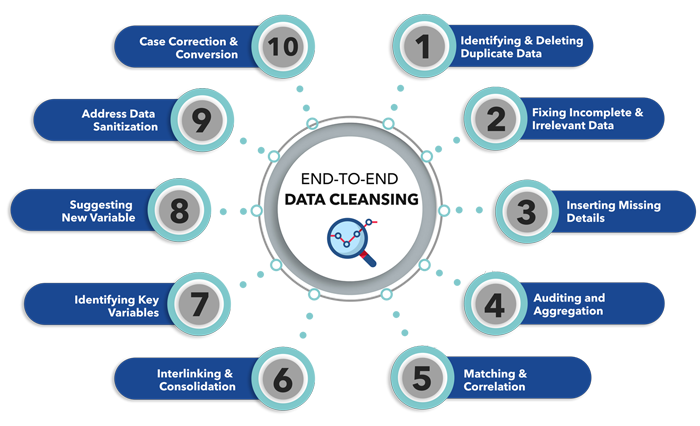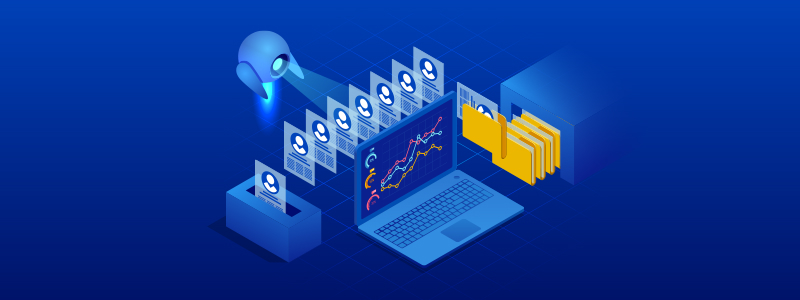The more data we generate, the more cleaning we must do. But what makes cleaning data so essential?
Gartner reveals that poor data quality costs businesses $12.9 million annually for businesses. Data cleansing is critical for any organization that relies on accurate data. The monetary cost is just one problem—poor-quality data also costs organizations and data scientists considerable time to fix. A recent survey revealed that data scientists spend as much as 60% of their time cleaning and organizing data.
What is Data Cleansing?

Source: Allied Infoline
Data cleansing, also known as data cleaning or data scrubbing, is the process of detecting and correcting (or removing) any errors or inconsistencies in data. As part of the overall data quality management framework, its primary goal is to improve data health, ensuring that information is accurate, consistent, and usable.
But why can’t we use raw data instead of spending so much time on data cleansing?
- Misspelled Entries: Typos and spelling mistakes can lead to categorization errors.
- Inconsistent Formats: Dates, numbers, or categories might be represented differently within the same dataset.
- Outliers and Errors: Unusual or erroneous entries can lead to inaccurate analysis.
- Duplicate Records: Redundant data can lead to inaccurate statistics and conclusions.
- Null or Missing Values: Incomplete data may lead to gaps in analysis and can lead to inaccurate and/or limited insights.
- Inaccurate Data: Incorrect or outdated information can lead to inaccurate decisions.
- Unstandardized Units: Different units of measurement can create data inconsistency issues, particularly when comparing or aggregating data.
- Incompatible Data: Conflicting data from different sources can cause discrepancies in data integration and analysis.
Data Cleansing Techniques
Cleaning the data addresses these challenges by using various techniques.
Removing Duplicates:
How to Do It: Utilize algorithms to identify and remove duplicate rows based on selected vital attributes.
Examples & Considerations: In a sales database, duplicates can arise from multiple entries for the same transaction. The data cleansing process involves merging or removing such duplicates to ensure accurate sales reporting.
Handling Missing Data:
How to Do It: Options include imputation, deletion, or using algorithms that can handle missing values. Imputation might use mean, median, or model-based strategies like k-NN.
Examples & Considerations: In a healthcare dataset, missing patient data, such as blood pressure readings, may be imputed using statistical methods to maintain data completeness and integrity.
Correcting Incorrect Data:
How to Do It: Utilize data validation rules, consistency checks, and manual review if needed. Data preparation tools can help in pattern matching and corrections.
Examples & Considerations: For instance, in a retail dataset, ensuring that all occurrences of “Los Angeles” are consistently spelled the same way, rather than appearing as “L.A.” or “LA,” ensures accurate location-based analysis and reporting.
Handling Outliers:
How to Do It: Identify outliers through statistical methods like the Z-score or IQR, then decide whether to cap, transform, or remove them.
Examples & Considerations: In financial data, an unusually high transaction amount may indicate fraud. Deciding how to handle such outliers is crucial for fraud detection and risk management.
Normalizing Data:
How to Do It: Apply techniques like Min-Max scaling, Z-score normalization, or log transformations.
Examples & Considerations: In a dataset with variables like temperature and humidity, normalization ensures that these variables are on a consistent scale, facilitating accurate weather prediction models.
Validating Data Consistency:
How to Do It: Create validation rules to check relationships and consistency across attributes.
Examples & Considerations: In an inventory database, validating that the total stock value matches the sum of individual item values is essential for inventory accuracy.
Transforming Data:
How to Do It: Use data transformations like encoding for categorical data or creating interaction terms based on analytical needs.
Examples & Considerations: In a recommendation system, one-hot encoding is applied to product categories to convert them into a format suitable for machine learning algorithms, improving the accuracy of product recommendations.
Benefits of Data Cleansing
Data cleansing is an essential component of the data processing pipeline. Rather than being a standalone task, it works in conjunction with other preprocessing techniques to prepare data for analysis. Normalization, transformation, and error correction are all integral to the data cleansing process. Benefits of data cleaning include:
- Enhanced Accuracy: Clean data leads to precise insights. Data cleansing establishes a solid foundation for accurate analysis and decision-making by removing errors and standardizing formats.
- Efficiency: Properly cleansed data streamlines the analysis process, minimizing the time spent on error detection and correction during the analytical stages.
- Revenue Growth: Clean data refines marketing strategies by offering insights into customer behavior, allowing for targeted campaigns. This accuracy in profiling helps tap into new opportunities and optimize offerings, boosting efficiency and driving revenue growth.
How to Choose the Right Data Cleansing Tool
Understanding how to clean your data is only useful if you can apply these techniques effectively. Choosing the right tools can make this process seamless. It’s important to choose products that are aligned with your specific business needs. Let’s delve into how you can select the right data cleansing tool for your business:
Compatibility and Integration
It is important to select a data cleansing tool which is compatible with your existing systems and data formats. If, for example, your data is stored in SQL databases, the selected tool should be able to connect to and manipulate this data directly. Consider support for a wide array of data sources like SQL, NoSQL, and Excel, and the tool’s ease of connecting with other analytical platforms.
Ease of Use and Learning Curve
Finding a tool that is accessible to both beginners and experienced professionals is vital. Look for tools with intuitive interfaces that are suitable for users with varied experience levels. The availability of tutorials, documentation, and community support can ease the learning process, making the transition smooth for everyone involved.
Scalability and Performance
A tool’s ability to handle large datasets and scale with growing data needs is crucial, especially for organizations with large volumes of data. Solutions that can manage large-scale operations efficiently might be the perfect fit. Assessing the speed and responsiveness of various cleansing operations helps ensure the tool performs well under pressure.
Flexibility and Customization
It’s crucial to choose a data cleansing tool that can be customized to handle your unique or specialized data cleaning needs. You want a tool that allows you to create or modify custom rules if you deal with intricate data, such as specific financial formats or custom transaction categories. This adaptability ensures that you can tailor the data cleansing process to the unique aspects of your data, regardless of its complexity or the specific demands of your industry.
Data Quality Assurance
Continuous monitoring and data quality validation are essential, and robust features for visualization and reporting should assist in this task. Automation capabilities, data quality metric visualizations, and ongoing support should all factor into your decision.
Security
Ensuring that the tool adheres to relevant data protection standards is essential. When working with sensitive data, tools that provide encryption and follow industry-standard security protocols are crucial. A careful evaluation of the tool’s security features and compliance with industry standards can help you make an informed choice.
Cost and Support
Analyzing the pricing model, including subscription fees and any hidden costs, will help align the tool with your budget. Open-source options may be suitable for smaller budgets, while enterprise-grade solutions offer extensive support at a premium. Evaluating the quality of customer support, weighing free vs. paid options, and considering the overall value for investment are essential steps in finding the right tool for your organization.
Learn more about the best data cleaning tools.
Now that you have an understanding of what data cleansing entails and its significance in modern data-driven businesses, the next step is choosing the right tool. Astera has been rapidly gaining attention in various industries for its ease of use and robust data cleansing functionalities. Let’s explore what makes this tool a preferred choice for many organizations.
Astera: Your Gateway to Seamless Data Preparation
Astera is an intuitive and user-friendly data management platform that enables users to seamlessly extract, cleanse, and prepare the data. Its key features include:
- AI-Powered Data Extraction: Extract unstructured data in a few clicks.
- Interactive Data Profiling: Gain insights into your data visually.
- Automated Data Quality Checks: Implement standard quality rules.
- Data Transformation: Design transformations effortlessly.
- Integration with Various Sources: Connect with different data formats.
- Built-in Scheduling and Automation: Enhance efficiency with automated workflows.
Astera ReportMiner stands out for its scalability, quality assurance, and intuitive interface. It’s suitable for various industries, including retail, healthcare, and finance, and offers a cost-effective solution without compromising performance or security. Astera represents a strategic investment that can revolutionize how your organization handles data, enabling you to focus more on deriving insights and less on managing the intricacies of data cleaning.
Unlock the power of clean data today!
Your Data Preparation Journey Begins with a Click
Gain in-depth knowledge and practical insights into data quality management with our comprehensive eBook.
Download Now
Authors:
 Mariam Anwar
Mariam Anwar





